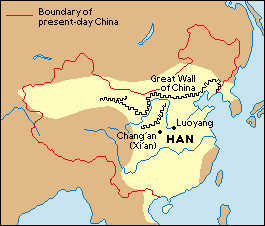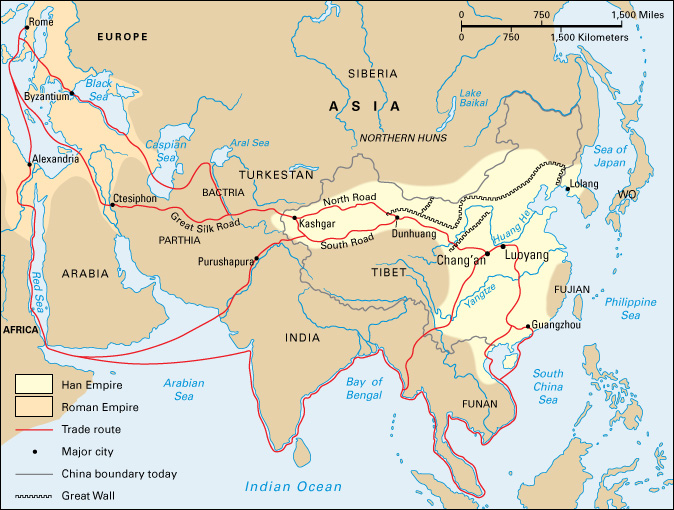Han, << hahn, >> dynasty was a series of emperors of the same family who ruled ancient China for over 400 years. Under Han rule, arts and sciences thrived and China became as large and as powerful as the Roman Empire. The Chinese still refer to themselves as Han people in recognition of China’s great achievements in this period.

Liu Bang (also spelled Liu Pang) became king of the Han in 206 B.C., after the fall of the Qin (Ch’in) dynasty (see Liu Bang ). He became emperor in 202 B.C. The Han rule was divided into two periods. The Former Han dynasty lasted from 206 B.C. to A.D. 8. Its capital was Chang’an (now Xi’an). The Later Han dynasty lasted from A.D. 25 to 220, and its capital was Luoyang. Because Chang’an lay west of Luoyang, the two periods are also called the Western and Eastern Han dynasties. From A.D. 8 to 23, China was ruled by Wang Mang, who set up the Xin (Hsin) dynasty. After the Xin fell, the Han soon regained control.
Han emperors after Liu had a strong centralized government. They used a civil service examination to select officials. This examination stressed knowledge of the teachings of Confucius. As a result, Confucian scholars held important government positions. Emperor Wudi, who ruled from 140 to 87 B.C., made Confucianism the state philosophy (see Confucianism ).
During the Han rule, education gained in importance and a central university was built in Chang’an. Han poets and prose writers developed a clear style that is still famous in Chinese literature. Scholars wrote long histories of China. Artists produced glazed pottery and large stone carvings.
Han China expanded southwest to what is now Tibet. Han warriors also conquered what are now North Korea and northern Vietnam and overcame nomadic tribes in the north and west. Overland trade routes linked China with Europe for the first time. Along the most famous route, the Silk Road, Chinese silk and other products flowed into the Roman Empire.

The Han dynasty collapsed because of rivalries among powerful families, scholar-officials, imperial relatives, advisers, and generals. For the next 360 years, China was divided into warring states.
See also China (The Han dynasty) ; Legalism .
